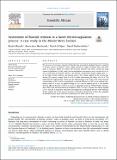| dc.contributor.author | Mureth, Risala | |
| dc.contributor.author | Machunda, Revocatus | |
| dc.contributor.author | Njau, Karoli | |
| dc.contributor.author | Dodoo-Arhin, David | |
| dc.date.accessioned | 2021-03-29T06:34:41Z | |
| dc.date.available | 2021-03-29T06:34:41Z | |
| dc.date.issued | 2021-03-04 | |
| dc.identifier.uri | https://doi.org/10.1016/j.sciaf.2021.e00737 | |
| dc.identifier.uri | https://dspace.nm-aist.ac.tz/handle/20.500.12479/1147 | |
| dc.description | This research article published by Elsevier B.V., 2021 | en_US |
| dc.description.abstract | The presence of excessive amounts of fluoride than prescribed standards has been reported
in various sources of domestic water supply around the slopes of Mount Meru and other
parts in Tanzania. Efforts to remove the excessive fluoride have been carried out using
various technologies. In this study, electrocoagulation experiments were carried out to assess its efficiency on fluoride removal. The fluoride concentration tested ranged from 1.37
to 48 mg/L in both synthetic and natural waters. The voltage applied in the electrocoagulation (EC) process ranged from 0 to 50 V while maintaining pH values of 4 to 9. The
representative experimental results for the Ngarenanyuki river water with initial fluoride
concentration of 29.5 mg/L accomplished a removal efficiency of 90% at an optimal electrolysis time of 30 min, an applied voltage of 30 V and an optimal pH of 6. The method
showed efficient fluoride removal in water to allowable limits by World Health Organization (WHO) and Tanzania Bureau of Standards (TBS) (1.5 mg/L). Despite the voltage applied
(30 V), the pH at neutrality remained unchanged thus making the process more efficient.
At this voltage (30 V) the process has been reported previously also to have the capability
of disinfecting the water and hence rendering such water safe for use | en_US |
| dc.language.iso | en | en_US |
| dc.publisher | Elsevier B.V. | en_US |
| dc.subject | Research Subject Categories::NATURAL SCIENCES | en_US |
| dc.title | Assessment of fluoride removal in a batch electrocoagulation process: A case study in the Mount Meru Enclave | en_US |
| dc.type | Article | en_US |

